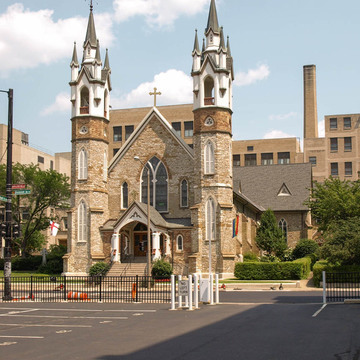St. Mark's exterior walls are built of the favored early stone building material of Grand Rapids—limestone rubble quarried from the bed of the Grand River and hauled by oxen to the site. The walls were probably laid by Ebenezer Anderson.
David J. Burger, an envoy of the Episcopal bishop of Michigan, organized St. Mark's Episcopal Church of the village and county of Kent in 1836. Its first meeting place was a home donated by Mr. and Mrs. E. P. Fuller. The wardens and vestry transferred the church to the trustees of the Grand Rapids Baptist Church and Society, who moved it off the site to make way for this Gothic Revival church.
The designer was a member of the church. His intent and that of the Reverend Francis H. Cuming, rector of St. Mark's, was to recall and copy as closely as possible the details of “'old Trinity' Church in New York City.” The Grand Rapids Enquirer for October 11, 1848, thought the “stone Gothic architecture well adapted to religious uses and influences . . . an ecclesiastical edifice surpassing any outside of our state metropolis.” Indeed, in 1848, St. Mark's Episcopal Church was the largest church west of Detroit. Two years after the gabled church was consecrated, twin octagonal towers with wood spires and pinnacles were added to the west facade. Inside, parishioners are seated beneath a hammer-beam roof. T. C. Esser Company Stained Glass Studios of Milwaukee made the Adoration of the Magi window for St. Mary's Chapel at the church in 1959.


